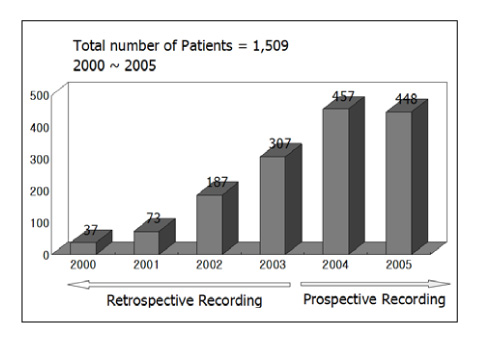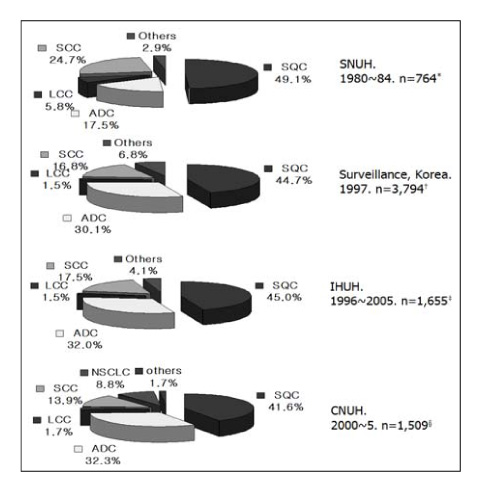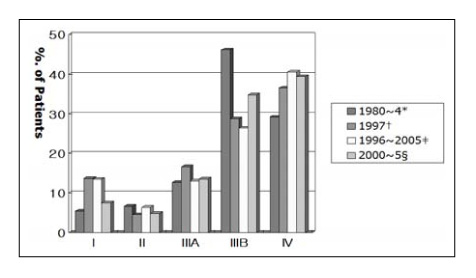Tuberc Respir Dis.
2006 Nov;61(5):427-432. 10.4046/trd.2006.61.5.427.
Clinical Characteristics of Lung Cancer Diagnosed in Chonnam National University Hospital(CNUH) Since 2000
- Affiliations
-
- 1Department of Internal Medicine, Chonnam National University Medical School, Gwangju, South Korea. kyc0923@jnu.ac.kr
- KMID: 1970247
- DOI: http://doi.org/10.4046/trd.2006.61.5.427
Abstract
-
BACKGROUND: Lung cancer has been the leading cause of cancer death in South Korea since 2000. This study examined the clinical characteristics of lung cancer patients diagnosed in a community hospital from the year 2000 to 2005, and compared these results with previously reported statistical data.
METHOD: The lung cancer data in a form of an electronic medical record was downloaded from the hospital medical information system. The clinical characteristics of the 1,509 patients with lung cancer were analyzed retrospectively.
RESULT: The mean age of the patients was 63.7 years. 82.5% and 74.5% of the patients were men and smokers, respectively. Squamous cell carcinoma (41.6%) was the most common pathology type followed by adenocarcinoma(32.3%) and small cell carcinoma(13.9%). When 604 patients who were diagnosed from 2000 to 2003 were compared with 905 patients diagnosed from 2004 to 2005, the age of patients increased significantly (61.5 years vs. 65.1 years; p<0.001) and the proportion of adenocarcinomas was significantly higher(29.3% vs. 34.4%; p=0.046).
CONCLUSION
Among the major histology types of lung cancer, the incidence of adenocarcinoma has been increasing recently. The age of the lung cancer patients at diagnosis is getting older. This is despite the fact that the distributions of the initial anatomic stages have not changed significantly.
Keyword
MeSH Terms
Figure
Reference
-
1. Korea National Statistical Office. 2004 Death rate statistics of Korea. 2005.2. Wynder EL, Muscat JE. The changing epidemiology of smoking and lung cancer histology. Environ Health Perspect. 1995. 103:143–148.3. Lynch TJ, Bell DW, Sordella R, Gurubhagavatula S, Okimoto RA, Brannigan BW, et al. Activating mutations in the epidermal growth factor receptor underlying responsiveness of non-small cell lung cancer to gefitinib. N Engl J Med. 2004. 350:2129–2139.4. Kim KS, Jeong JY, Kim YC, Na KJ, Park CS, Baek SM, et al. Predictors of response to gefitinib in refractory non-small cell lung cancer. Clin Cancer Res. 2005. 11:2244–2251.5. Kim HJ, Jeong MP, Heo DS, Bang YJ, Han SK, Shin YS, et al. Lung cancer in Korea (1980-1984). Korean J Med. 1994. 46:221–228.6. Scientific Committee of Korean Academy of Tuberculosis and Respiratory Disease. The National Survey of Lung Cancer in Korea. Tuberc Respir Dis. 1999. 46:455–465.7. Ryu JS, Lee HJ, Leem JH, Kim L, Lee KH, Cho JH, et al. Clinical characteristics of primary lung cancer patients in a Tertiary Hospital. Tuberc Respir Dis. 2006. 60:321–329.8. Munden RF, Swisher SS, Stevens CW, Stewart DJ. Imaging of the patient with non-small cell lung cancer. Radiology. 2005. 237:803–818.9. Jackman DM, Johnson BE. Small-cell lung cancer. Lancet. 2005. 366:1385–1396.10. Erasmus JJ, Truong MT, Munden RF. CT, MR, and PET imaging in staging of non-small-cell lung cancer. Semin Roentgenol. 2005. 40:126–142.11. Kawamukai K, Cesario A, Margaritora S, Meacci E, Piraino A, Vita ML, et al. TNM independent prognostic factors in lung cancer. Rays. 2004. 29:373–376.12. Kawamukai K, Cesario A, Margaritora S, Meacci E, Piraino A, Vita ML, et al. TNM independent prognostic factors in lung cancer. Rays. 2004. 29:373–376.13. Alberg AJ, Samet JM. Epidemiology of lung cancer. Chest. 2003. 123:21S–49S.14. Patel JD, Bach PB, Kris MG. Lung cancer in US women: a contemporary epidemic. JAMA. 2004. 291:1763–1768.15. Janssen-Heijnen ML, Coebergh JW. The changing epidemiology of lung cancer in Europe. Lung Cancer. 2003. 41:245–258.16. Osann KE. Epidemiology of lung cancer. Curr Opin Pulm Med. 1998. 4:198–204.
- Full Text Links
- Actions
-
Cited
- CITED
-
- Close
- Share
- Similar articles
-
- Establishment of a Cell Line (CNUH-HNSCC-1) Derived from an Advanced Laryngeal Squamous Cell Carcinoma
- Collaborative Care to Relieve Psychological Distress in Patients with Medically Inoperable Lung Cancer: Design and Rationale for a Clinical Trial
- The Development of the Korean Lung Cancer Registry (KALC-R)
- Clinical Efficacy of Belotecan (CKD-602), Newly Developed Camptothecin Analog, in the 2nd Line Treatment of Relapsed Small Cell Lung Cancer
- Lung Cancer: Overview




